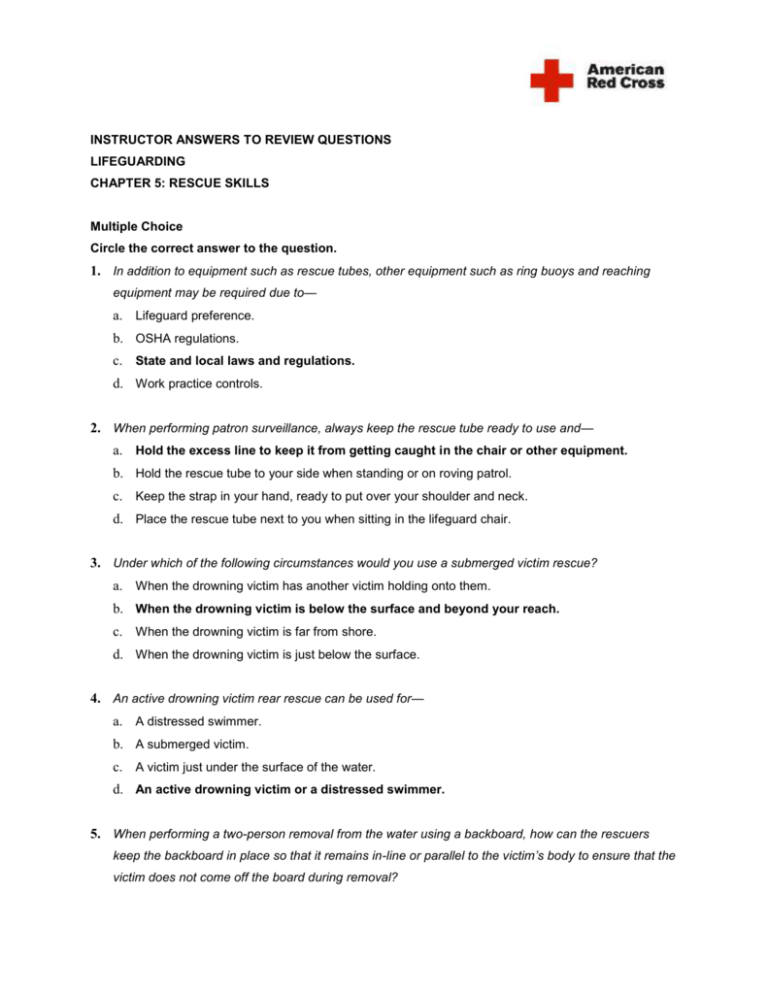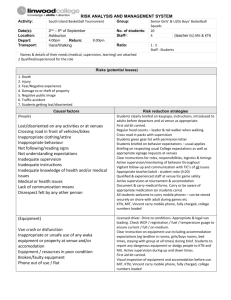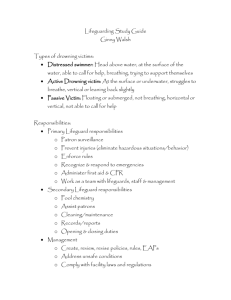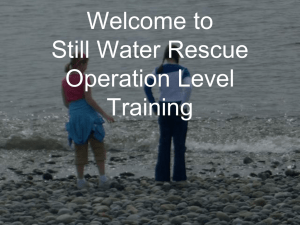Chapter-5-Teacher
advertisement

INSTRUCTOR ANSWERS TO REVIEW QUESTIONS LIFEGUARDING CHAPTER 5: RESCUE SKILLS Multiple Choice Circle the correct answer to the question. 1. In addition to equipment such as rescue tubes, other equipment such as ring buoys and reaching equipment may be required due to— a. Lifeguard preference. b. OSHA regulations. c. State and local laws and regulations. d. Work practice controls. 2. When performing patron surveillance, always keep the rescue tube ready to use and— a. Hold the excess line to keep it from getting caught in the chair or other equipment. b. Hold the rescue tube to your side when standing or on roving patrol. c. Keep the strap in your hand, ready to put over your shoulder and neck. d. Place the rescue tube next to you when sitting in the lifeguard chair. 3. Under which of the following circumstances would you use a submerged victim rescue? a. When the drowning victim has another victim holding onto them. b. When the drowning victim is below the surface and beyond your reach. c. When the drowning victim is far from shore. d. When the drowning victim is just below the surface. 4. An active drowning victim rear rescue can be used for— a. A distressed swimmer. b. A submerged victim. c. A victim just under the surface of the water. d. An active drowning victim or a distressed swimmer. 5. When performing a two-person removal from the water using a backboard, how can the rescuers keep the backboard in place so that it remains in-line or parallel to the victim’s body to ensure that the victim does not come off the board during removal? a. By lifting the backboard from the water very quickly b. By moving the victim onto the backboard as quickly as possible c. By placing his or her foot closest to the backboard against the edge of the board d. By pressing down evenly with the opposite hands on the backboard 6. How do you approach the victim using a rescue board when rescuing a distressed swimmer or active drowning victim? a. Approach the victim either face first or from the rear, making sure to approach bow first. b. Approach the victim face first, so that the bow of the rescue board is in front of the victim. c. Approach the victim from the rear, so that the bow of the rescue board is behind the victim. d. Approach the victim from the side, so that the side of the rescue board is next to the victim. 7. Which of the following statements is true if your facility has rescue water craft available for rescues? a. Lifeguards are responsible to purchase equipment for use in the rescue water craft. b. Management must train lifeguards in the use of its rescue water craft. c. Rescue water craft is expensive equipment and should not be used for practice purposes. d. When rescue water craft is available, a lifeguard is not needed. Matching 8. Match each term with the correct definition. A. Reaching pole B. Rescue board C. Rescue tube D. Ring buoy E. Shepherd’s crook B Made of plastic or fiberglass, it is similar in shape to a surf board. Primarily used at waterfronts. C Made of vinyl, it is a 45- to 54-inch long foam-filled device with an attached tow line and shoulder strap. D Made of buoyant material, it typically ranges from 20 to 30 inches in diameter with an attached line that ranges from 30 to 60 feet. A Made of aluminum or fiberglass, it is usually about 10 to 15 feet long. E Made of aluminum or fiberglass, it is usually about 10 to 15 feet long with a large hook on one end. 9. Match each term with the correct definition. A. Compact jump B. Run-and-swim entry C. Slide-in entry D. Stride jump A Used when the lifeguard is more than 3 feet above the water, but only if the water is at least 5 feet deep. Can also be done from a pool deck into the water. C Used in shallow water; crowded pools; or when a victim with a head, neck or back injury is close to the side of the pool or pier. B Used to enter the water from a gradual slope, such as a shoreline or wave pool. D Used with a rescue tube only if the water is at least 5 feet deep and the lifeguard is no more than 3 feet above the water. 10. Match each term with the correct definition. A. Extension assist from the deck B. Reaching assist with equipment C. Simple assist D. Throwing assist B Used with equipment when the victim is close to the deck, shoreline or pier and beyond the range of the rescue tube. Equipment is used to extend the rescuer’s reach out or to bring the victim closer. D Used with equipment when a distressed swimmer is beyond the range of a reaching device. A Used with a rescue tube when a victim is close to the side of the pool or a pier. The assist is completed by holding out the rescue tube to a distressed swimmer from the pool deck or pier. C Used in shallow water, this assist may be as easy as helping a person to his or her feet or helping the person maintain his or her balance. 11. Match each term with the correct definition. A. Beach drag B. Front-and-back carry C. Two-person removal from the water using a backboard D. Walking assist C Used to remove a possibly unconscious victim from the water at the edge of the pool or a pier and a head, neck or back injury is not suspected. D Used to remove a conscious victim from shallow water. A Used to remove a victim who is unconscious or who cannot walk from the water where a gradual slope or zero-depth exit is present and a head, neck or back injury is not suspected. B Used by two rescuers in shallow water with a zero-depth exit or gradual slope if the victim is unconscious or cannot get out of the water without help and a head, neck or back injury is not suspected. Multiple Answers Place a check next to the correct answer or answers. 12. Place an “S” for the steps common to a shallow-water line search and a “D” for the steps common to a deep-water line search. D Searchers must be lifeguards. D Uses a surface dive. D Used in water greater than chest deep. S Searchers can be volunteers. S Used in water less than chest deep. D Searchers form a straight line an arm’s length from each other. D Searcher swim forward a set number of strokes. D Searchers return to the surface as straight up as possible. S Searcher should link arms and hold hands in a straight line. S As the line moves slowly forward, searchers sweep their feet across the bottom. True or False Circle true or false. 13. True False During a drowning, the lifeguard recognizes an emergency in the water, activates the EAP, uses rescue equipment and follows the general procedures for a water emergency. 14. True False Assists are the most common help given to patrons, especially at waterparks. 15. True False When completing the passive submerged victim rescue in deep water, if the victim is deeper than the strap and towline can extend, release the strap and towline, grasp the victim, push off the bottom (if possible) and kick to the surface. 16. True False A multiple-victim rescue is controlled best by one rescuer. 17. True False A feet-first surface dive may need to be performed during an escape. 18. True False When rescuing someone who is unconscious or cannot hold or climb onto the rescue board, use caution when flipping the board to ensure that the victim’s armpits and upper arms remain along the edge of the rescue board during the flip. 19. True False Fins with larger blades are better for someone who may be a weaker swimmer. 20. True False An underwater search for a scuba diver in open water should be conducted by trained search-and-rescue scuba personnel, even when lifeguards are present. Fill in the Blanks 21. The type of entry used to enter the water during a rescue depends on— a. The depth of the water. b. The lifeguard station—whether the lifeguard station is elevated or at ground level. c. Obstacles in the water, such as patrons, lane lines and safety lines. d. The location and condition of the victim. e. The design of the facility. 22. The best way to approach a victim during a short distance rescue is with a modified front crawl or breaststroke. 23. Use the passive submerged victim rescue for shallow water when the victim is face-down, at or near the surface but seems unconscious and a head, neck or back injury is not suspected. 24. If a rescue tube is lost during the rescue and a drowning victim grabs onto the lifeguard, a(n) escape should be used. 25. When performing a beach drag, walk backwards using your legs, not your back, and drag the victim out of the water. 26. Keep a rescue board clean of suntan lotions and body oils, which can make it slippery. 27. To use a rescue board, hold on to the sides about mid-board when entering the water. Once you are in knee deep water, lay the rescue board down on the water and push it forward. Climb onto the rescue board just behind the middle and lie down. 28. When paddling on a rescue board in the prone position, use either the front crawl or butterfly arm strokes. 29. A mask is made up of soft, flexible material, with nontinted, tempered safety glass and a head strap that can be easily adjusted. 30. Cold water is generally defined as water 70° F or colder. Ordering Place the following in the correct order. 31. Place in sequence the nine steps a lifeguard takes when performing a rescue. 2 Activates the EAP 4 Assesses the victim’s condition 9 Provides emergency care as needed 1 Recognizes an emergency in the water 6 Performs an appropriate rescue 3 Uses rescue equipment 8 Removes the victim from the water 7 Moves the victim to safety 5 Safely enters the water, if needed 32. Place in order the first three steps necessary to perform an escape immediately after the victim grabs a lifeguard. 2 Tuck the chin 3 Turn the head to either side 1 Take a quick breath of air Circle the Correct Answer from the Pair 33. (Use/Do not use) the passive drowning victim rear rescue technique for a victim who is suspected of having a head, neck or back injury. 34. When performing a two-person removal from the water using a backboard, the second rescuer who is on deck (crosses/does not cross) his or her hands to grab the victim’s wrists. 35. To rescue someone who is unconscious or cannot hold or climb onto the rescue board, make sure the victim’s armpits (are/are not) along the edges of the board. 36. The initial assessment of a victim of a cold water drowning (may/does not) require more to time to complete since vitals signs may be slowed. 37. For the safety of the lifeguard, a line and reel (should/should not) be used when entering cold water to complete a rescue. Short Answer 38. List at least three things to consider when deciding to remove a victim from the water. Answers should include any three of the following: o o o o The victim’s condition The victim’s size How soon help is expected to arrive Whether anyone can help 39. What is the most important thing to remember about a reaching assist with equipment or a throwing assist after the equipment is extended or thrown to the victim? Keep the body low and lean back to avoid being pulled into the water by the victim. 40. Name the primary piece of rescue equipment used by lifeguards. The rescue tube 41. List four important reasons for using the rescue tube to perform a water rescue. o The rescue tube helps the lifeguard and the victim stay afloat. o The rescue tube keeps the victim’s mouth above water while the lifeguard brings the victim to safety. o The rescue tube makes it easier to move the victim to safety. o The rescue tube reduces the chances of the victim grabbing the lifeguard during the rescue. 42. List in the correct order the five steps for completing a swimming extension rescue for a distressed victim. 1. Approach the victim from the front. 2. Extend the end of the rescue tube to the victim. 3. Tell the victim to hold on to the rescue tube and kick if he or she can. 4. Tow the victim to safety, being sure to maintain visual contact. 5. Reassure the victim. 43. List the condition(s) when it is appropriate to use a passive drowning victim rear rescue. The victim is at or near the surface; seems unconscious; and a head, neck or back injury is not suspected. 44. What is the goal in a passive drowning victim rear rescue? To put the rescue tube under the victim’s shoulders or back to support him or her face- up. 45. In what circumstances would a lifeguard use a feet-first surface dive when performing a rescue? To rescue or search for a submerged victim in deep water. 46. List the four options lifeguards can use to remove a victim from the water. o o o o Two-person removal from the water using a backboard Walking assist Beach drag Front-and-back carry 47. You are performing an active drowning victim rear rescue. After squeezing the rescue tube between your chest and the victim’s back, why do you turn your head to one side before leaning back and pulling the victim onto the rescue tube? To avoid being hit by the victim’s head if it moves backward. 48. List two reasons why properly positioning the victim on the rescue tube is important when performing a water rescue? o To support the victim with his or her mouth out of the water o To support the victim with control to allow you to swim with the victim to safety 49. You are performing a rescue and lose contact with the victim. The victim grabs you from the front and tries to climb on top of you to get a breath. What should you do? Perform a front head-hold escape, reposition the rescue tube and reattempt the rescue 50. In a waterfront situation when a drowning victim submerges, what can lifeguards do to help mark the victim’s last known position? Take a sighting or a cross-bearing to keep track of where the victim went under 51. List the three major principles to follow when using a motorized watercraft to make a rescue. o Always approach the victim from downwind and downstream. o Shut off the engine about three boat lengths from the victim. o Bring the victim on board before restarting the engine. 52. In some ways, cold water can be beneficial and may increase a person’s chance of survival in a drowning. Explain why this would be true. o The body temperature begins to drop as soon as the person enters the water. o As the body’s core temperature drops, body functions slow and the person requires very little oxygen. o Any oxygen left in the blood is diverted to the brain and heart to maintain minimal functioning of these vital organs. 53. How do you check that a mask fits properly? o o o o Place the mask against the face without using the strap. Inhale slightly through the nose to create a slight suction inside the mask. Adjust the strap so that the mask is comfortable. Try the mask in the water.







